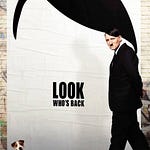I first heard of the movie Blackboard Jungle while reading Derek Thompson’s Hit Makers: The Science of Popularity in an Age of Distraction. The film is most remembered today for opening with the song Rock Around the Clock by Bill Haley & His Comets, which set off the rock and roll revolution and everything that came after it.
Blackboard Jungle is a story mostly told through the perspective of an inner-city teacher named Richard Dadier, and serves as a way to showcase what at the time was considered urban dysfunction among teenage boys.
Here’s how Thompson describes the significance of the film and its opening track.
“The breakout success of ‘Rock Around the Clock’ had everything to do with its placement at the beginning of the film Blackboard Jungle,” said Jim Dawson, author of Rock Around the Clock: The Record That Started the Rock Revolution. The reaction to Blackboard Jungle was something like hysteria — not just among teenagers, but also among their parents and politicians. Kids danced in the aisles of movie theaters and blasted the song from their cars. On May 17 1955, the Philadelphia Inquirer reported that Princeton University dorms held a competition to play the song as loudly as possible from their rooms. Around midnight, the students emptied into the quads, set fires to trashcans, and chanted up and down the streets. Meanwhile, several major American cities censored the film. The mayor of Memphis forbade teenagers to see it, while Atlanta tried to ban the movie after an alderman’s wife said it threatened the “peace, health, morals, and good order of this city.”
Just as l’affaire Caillebotte consecrated impressionism through scandal in the 1890s, Blackboard Jungle’s notoriety promoted its opening track, unleashing the rock-and-roll genre. On July 2, 1955, three months after Blackboard Jungle debuted, “Rock Around the Clock” became the top-selling single in the country and the first song called “rock ’n’ roll” to reach number one on the Billboard charts, ultimately selling more physical copies than any song by Elvis Presley, the Beatles, Madonna, or Michael Jackson.
One of the laws of chaos is that a microscopic change in the present trajectory can lead to wildly different future outcomes; the Brazilian butterfly shakes her wings, and a Pacific typhoon forms off the coast of Indonesia. The most popular melodies of 1954 and 1955 were dulcet waltzes next to the high-tempo hits of the later 1950s. Billboard’s number one songs before and after “Rock Around the Clock” were the schmaltzy “Unchained Melody” and the minstrel ballad “Yellow Rose of Texas,” which sounds like it could have been written in the 1850s.
Could what’s implied here possibly be true? That one song placed at the start of one film changed everything about music and ultimately led to a seismic shift in American culture, with implications for everything from education and crime to family formation? The possibility boggles the mind, but I can’t totally dismiss the idea. One thing I knew for sure after reading the passage above was that I needed to see this movie.
After tackling some deep questions about the causes of historical events and how contingent they might be, Rob and I focus on how race and gender issues are portrayed in the movie. On race, the film seems practically modern. Some themes and tropes that wouldn’t have been out of place in the 1990s or 2000s include: the middle-class professional being horrified at being accused of racism; the black kid having a good heart while only the white kid can be portrayed as pure evil; and the way that racial differences are downplayed in a social context. This last point is particularly striking, as a group of lower-class white boys has no racial consciousness at all, and for all practical purposes the young men treat their black and Hispanic classmates like they do anyone else.
When it comes to relations between the sexes, however, one sees the 1950s as a completely different universe. It is considered completely normal for the main female character to care primarily about her looks and keeping her husband happy. Overall, we see a great deal of stagnation in American culture on race, alongside radical changes in how men and women relate to one another.
While the movie’s portrayal of male-female relations lines up with popular propaganda about the 1950s, I found myself shocked at the difference between how that decade is commonly described and what was shown in this film. Surely, movies don’t perfectly reflect reality, but the fact that this particular representation of race relations was plausible to an audience of that time is surely worth noting. This experience has made both of us to want to watch other old films in order to have a more direct understanding of the cultures of past eras. Very little can be simply taken for granted.
Listen here or watch on YouTube.













